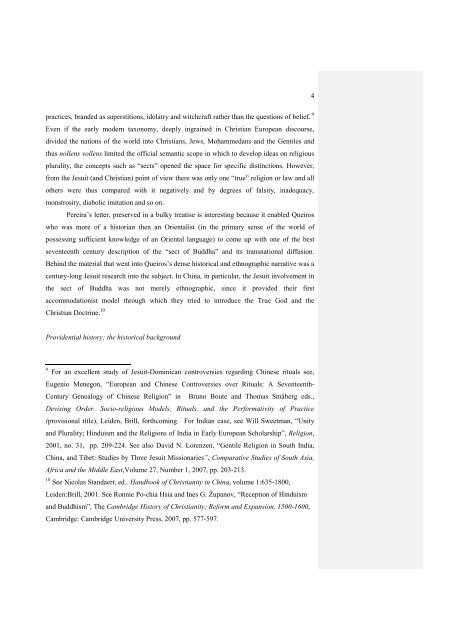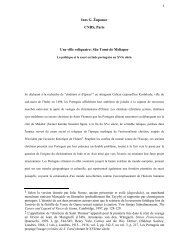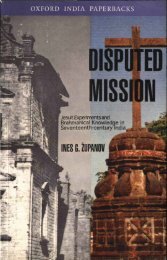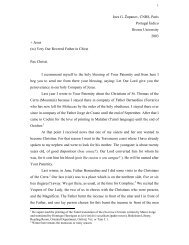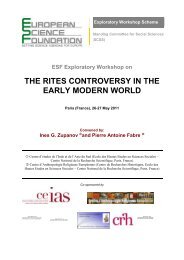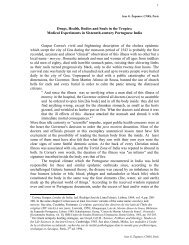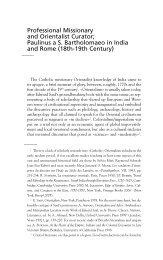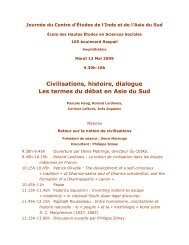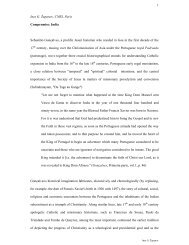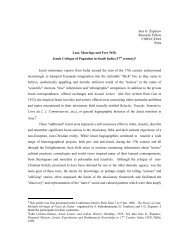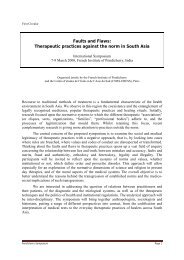Jesuit Orientalism; - Ines G. Županov
Jesuit Orientalism; - Ines G. Županov
Jesuit Orientalism; - Ines G. Županov
You also want an ePaper? Increase the reach of your titles
YUMPU automatically turns print PDFs into web optimized ePapers that Google loves.
4<br />
practices, branded as superstitions, idolatry and witchcraft rather than the questions of belief. 9<br />
Even if the early modern taxonomy, deeply ingrained in Christian European discourse,<br />
divided the nations of the world into Christians, Jews, Mohammedans and the Gentiles and<br />
thus nollens vollens limited the official semantic scope in which to develop ideas on religious<br />
plurality, the concepts such as “sects” opened the space for specific distinctions. However,<br />
from the <strong>Jesuit</strong> (and Christian) point of view there was only one “true” religion or law and all<br />
others were thus compared with it negatively and by degrees of falsity, inadequacy,<br />
monstrosity, diabolic imitation and so on.<br />
Pereira‟s letter, preserved in a bulky treatise is interesting because it enabled Queiros<br />
who was more of a historian then an Orientalist (in the primary sense of the world of<br />
possessing sufficient knowledge of an Oriental language) to come up with one of the best<br />
seventeenth century description of the “sect of Buddha” and its transnational diffusion.<br />
Behind the material that went into Queiros‟s dense historical and ethnographic narrative was a<br />
century-long <strong>Jesuit</strong> research into the subject. In China, in particular, the <strong>Jesuit</strong> involvement in<br />
the sect of Buddha was not merely ethnographic, since it provided their first<br />
accommodationist model through which they tried to introduce the True God and the<br />
Christian Doctrine. 10<br />
Providential history; the historical background<br />
9 For an excellent study of <strong>Jesuit</strong>-Dominican controversies regarding Chinese rituals see,<br />
Eugenio Menegon, “European and Chinese Controversies over Rituals: A Seventeenth-<br />
Century Genealogy of Chinese Religion” in Bruno Boute and Thomas Småberg eds.,<br />
Devising Order. Socio-religious Models, Rituals, and the Performativity of Practice<br />
(provisional title), Leiden, Brill, forthcoming. For Indian case, see Will Sweetman, “Unity<br />
and Plurality; Hinduism and the Religions of India in Early European Scholarship”, Religion,<br />
2001, no. 31, pp. 209-224. See also David N. Lorenzen, “Gentile Religion in South India,<br />
China, and Tibet: Studies by Three <strong>Jesuit</strong> Missionaries”, Comparative Studies of South Asia,<br />
Africa and the Middle East,Volume 27, Number 1, 2007, pp. 203-213.<br />
10 See Nicolas Standaert, ed., Handbook of Christianity in China, volume 1:635-1800,<br />
Leiden:Brill, 2001. See Ronnie Po-chia Hsia and <strong>Ines</strong> G. <strong>Županov</strong>, “Reception of Hinduism<br />
and Buddhism”, The Cambridge History of Christianity; Reform and Expansion, 1500-1600,<br />
Cambridge: Cambridge University Press, 2007, pp. 577-597.


